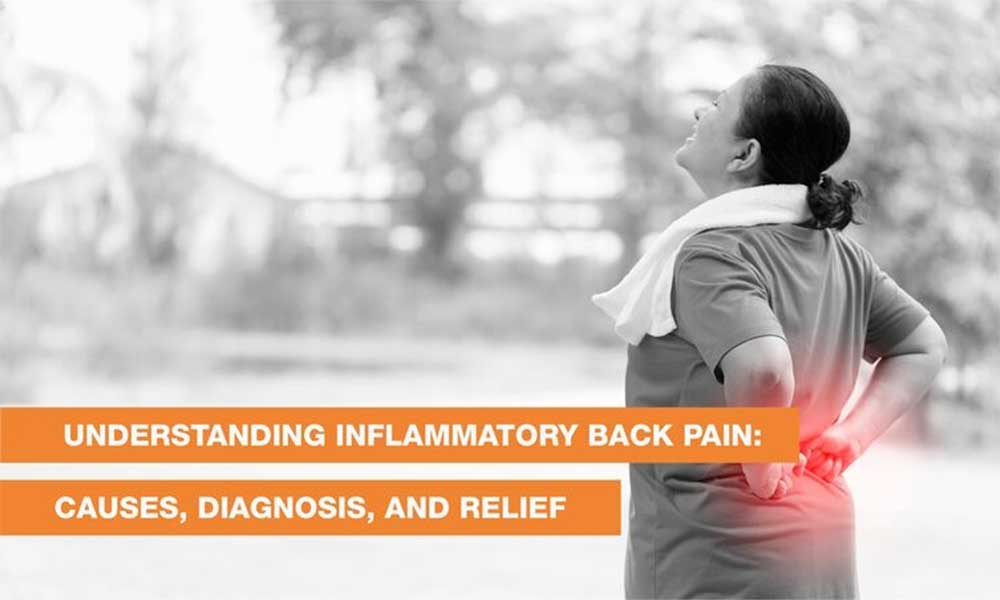Request Appointment
Enter your details and we will be in touch with you shortly;
Or call
8655885566
between 8 am and 8 pm.


Lower back pain is a common complaint. However, not all cases of back pain are similar. This blog will explore inflammatory back pain, its causes, and how it differs from other back issues. Will dive into inflammation of the spine, the role of lower back inflammation, and methods for proper inflammatory back pain diagnosis. Our goal is to empower you with the knowledge to recognise the signs and seek the right help, including the proper inflammatory back pain treatment for lasting relief.
Inflammatory back pain is chronic pain caused by an immune response. Unlike mechanical back pain from injury or strain, it arises due to spine inflammation. This condition is related to autoimmune diseases, including ankylosing spondylitis, rheumatoid arthritis, and back pain. The pain can be more or less. The pain is constant and is generally worse first thing in the morning. Recognising inflammatory back pain symptoms, like prolonged morning stiffness, is key to understanding your condition.
There are many potential reasons why the spine gets inflamed, including autoimmune diseases or long-term pressure on the spinal column’s bones. The body’s defense mechanism often mistakenly targets healthy tissue, leading to spine inflammation. This process instigates pain and inflammation of the back if not well handled.
Understanding inflammatory back pain symptoms is essential for early intervention. Here are some hallmark indicators:
Such symptoms differentiate inflammatory problems from other forms of back pain. Many people experience lower back inflammation as part of this condition, making it a critical sign to watch for.
Several factors contribute to inflammatory back pain. Knowing these risks is beneficial as it can help in their identification and mitigation:
Autoimmune disorders such as ankylosing sponditis, back pain, and autoimmune back pain compel the immune system to attack the spine.
One of the causes of this condition is having a family history of spinal inflammatory diseases.
Ongoing lower back inflammation may be a sign of systemic inflammatory issues.
Lack of physical activity and improper posture may worsen the inflammation of the spine, though they are more directly associated with mechanical back pain.
Learning the risk factors, such as spinal inflammation causes, will assist in determining the best approach to managing the condition for the best results and with necessary lifestyle changes.
Early and accurate inflammatory back pain diagnosis is essential to managing the condition effectively. The diagnosis process typically includes:
A comprehensive evaluation ensures you receive the correct inflammatory back pain diagnosis, paving the way for targeted treatment.
Managing inflammatory back pain involves a multifaceted approach. Here are key strategies:
Anti-inflammatory drugs help reduce lower back inflammation and control pain. These medications are part of an effective inflammatory back pain treatment plan.
Stretching exercises enable individuals to build up their muscular flexibility and muscular strength. Therapies may include stretches and posture correction to reduce inflammation of the spine.
Proper work equipment and position, correct sleeping position, and undertaking low-impact exercising benefited the spine.
Yoga, mindfulness, and massage can enhance well-being and relieve inflammatory back pain.
By following these strategies, the chest pain is managed, and the chance of any more harm is also avoided. In chronic conditions, therefore, a consistent program of medical care and a change in behavior patterns is the key to practicing for an extended period.
These tips help them to avoid the possibilities of developing hurt back muscles, which is why it’s essential to practice activities and routines that contribute to the improvement of spinal health every day.
Understanding inflammatory back pain is crucial for managing and preventing further spinal issues. Recognise the symptoms, such as prolonged morning stiffness, and seek an early inflammatory back pain diagnosis. You can reduce spine inflammation and ease lower back pain with the proper inflammatory back pain treatment and lifestyle changes.
Your journey to a healthier spine starts today. When seeking to start pain management, visit QI Spine for professional consultation on appropriate physiotherapy of back pain problems from our expert spine doctors. Improve your life by starting on the right path to decreasing pain by caring for your physical health.
Visit our nearest clinic for your first consultation
Inflammatory back pain improves with movement and presents with morning stiffness, unlike mechanical pain. Look for classic inflammatory back pain symptoms.
Yes, prolonged inflammation of the spine may cause structural changes if untreated. Early intervention is key.
Yes, lower back inflammation might indicate underlying autoimmune or spinal inflammatory diseases. Prompt evaluation is essential.